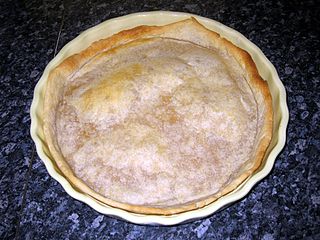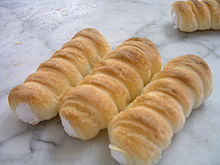
Shortcrust is a type of pastry often used for the base of a tart, quiche, pie, or flan. Shortcrust pastry can be used to make both sweet and savory pies such as apple pie, quiche, lemon meringue or chicken pie.

Cake is a flour confection made from flour, sugar, and other ingredients and is usually baked. In their oldest forms, cakes were modifications of bread, but cakes now cover a wide range of preparations that can be simple or elaborate and which share features with desserts such as pastries, meringues, custards, and pies.

Meringue is a type of dessert or candy, of French origin, traditionally made from whipped egg whites and sugar, and occasionally an acidic ingredient such as lemon, vinegar, or cream of tartar. A binding agent such as salt, flour or gelatin may also be added to the eggs. The key to the formation of a good meringue is the formation of stiff peaks by denaturing the protein ovalbumin via mechanical shear.

Dough is a thick, malleable, sometimes elastic paste made from grains or from leguminous or chestnut crops. Dough is typically made by mixing flour with a small amount of water or other liquid and sometimes includes yeast or other leavening agents, as well as ingredients such as fats or flavorings.

Lemon meringue pie is a dessert pie consisting of a shortened pastry base filled with lemon curd and topped with meringue.

Cheesecake is a dessert made with a soft fresh cheese, eggs, and sugar. It may have a crust or base made from crushed cookies, graham crackers, pastry, or sometimes sponge cake. Cheesecake may be baked or unbaked, and is usually refrigerated.

Icing, or frosting, is a sweet, often creamy glaze made of sugar with a liquid, such as water or milk, that is often enriched with ingredients like butter, egg whites, cream cheese, or flavorings. It is used to coat or decorate baked goods, such as cakes. When it is used between layers of cake it is known as a filling.

Shortcake generally refers to a dessert with a crumbly scone-like texture. There are multiple variations of shortcake, most of which are served with fruit and cream. One of the most popular is strawberry shortcake, which is typically served with whipped cream. Other variations common in the UK are blackberry and clotted cream shortcake and lemon berry shortcake, which is served with lemon curd in place of cream.

A profiterole, cream puff (US), or chou à la crème is a filled French choux pastry ball with a typically sweet and moist filling of whipped cream, custard, pastry cream, or ice cream. The puffs may be decorated or left plain or garnished with chocolate sauce, caramel, or a dusting of powdered sugar. Savory profiterole are also made, filled with pureed meats, cheese, and so on. These were formerly common garnishes for soups.

A mille-feuille, also known by the names Napoleon in North America, vanilla slice in the United Kingdom, and custard slice, is a French dessert made of puff pastry layered with pastry cream. Its modern form was influenced by improvements made by Marie-Antoine Carême.

A macaron or French macaroon is a sweet meringue-based confection made with egg white, icing sugar, granulated sugar, almond meal, and often food colouring.

A cremeschnitte, also known as vanilla slice or custard slice, is a custard and chantilly cream cream cake dessert commonly associated with the former Austro-Hungarian Monarchy. However, its exact origin is unknown. This dish remains popular across Central Europe and the Balkans in various variations, all of which include a puff pastry base and custard cream.

Buttercream, also referred to as butter icing or butter frosting, is used for either filling, coating or decorating cakes. The main ingredients are butter and some type of sugar.

A lemon tart is a dessert dish, a variety of tart. It has a pastry shell with a lemon flavored filling.

Sponge cake is a light cake made with egg whites, flour and sugar, sometimes leavened with baking powder. Some sponge cakes do not contain egg yolks, like angel food cake, but most of them do. Sponge cakes, leavened with beaten eggs, originated during the Renaissance, possibly in Spain. The sponge cake is thought to be one of the first non-yeasted cakes, and the earliest attested sponge cake recipe in English is found in a book by the English poet Gervase Markham, The English Huswife, Containing the Inward and Outward Virtues Which Ought to Be in a Complete Woman (1615). Still, the cake was much more like a cracker: thin and crispy. Sponge cakes became the cake recognised today when bakers started using beaten eggs as a rising agent in the mid-18th century. The Victorian creation of baking powder by English food manufacturer Alfred Bird in 1843 allowed the addition of butter to the traditional sponge recipe, resulting in the creation of the Victoria sponge. Cakes are available in many flavours and have many recipes as well. Sponge cakes have become snack cakes via the Twinkie.

Schaumrollen, or Schillerlocken, are an Austrian confection. They consist of a cone or tube of puff pastry filled with whipped cream or meringue. They are about 3 inches (7.6 cm) wide. The pastries are made by wrapping thin pastry strips around a cone shaped metal tube. After baking, they are filled with the "foam", which is usually sweetened whipped cream or meringue. The pastry tubes are often rolled in coarse sugar or powdered sugar before baking, for extra sweetness and a crunchy texture.
Pie in American cuisine has roots in English cuisine and has evolved over centuries to adapt to American cultural tastes and ingredients. The creation of flaky pie crust shortened with lard is credited to American innovation.
The fourth season of The Great Canadian Baking Show premiered on CBC Television on February 14, 2021. As with previous seasons, ten amateur bakers will compete over eight weeks of challenges, vying for the title. The season marked the debut of Ann Pornel and Alan Shane Lewis as hosts, who replaced Carolyn Taylor and Aurora Browne. Bruno Feldeisen and Kyla Kennaley returned for their fourth and second seasons respectively as judges.

















